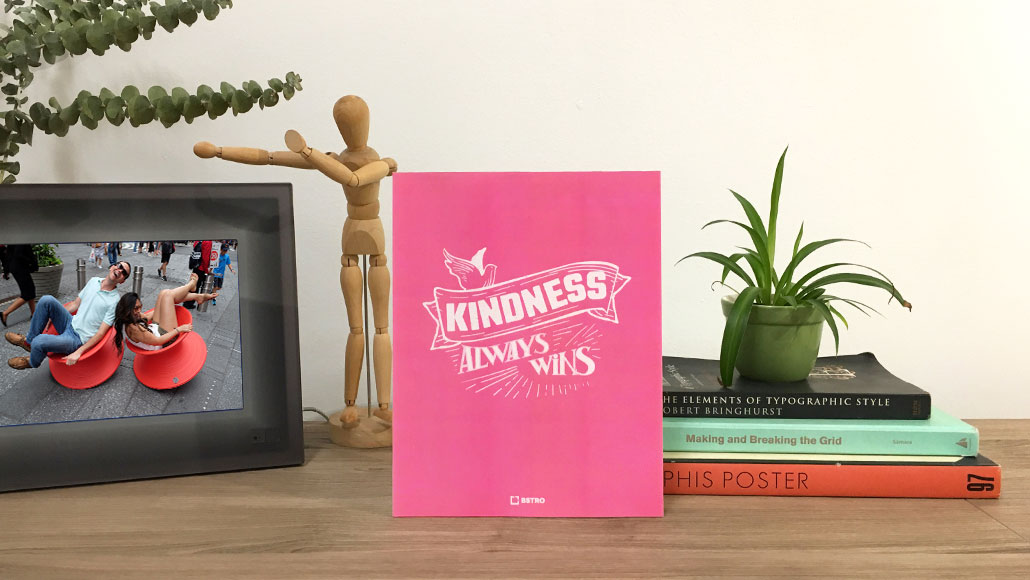Clearly, movies have not adequately prepared us for the reality of relationships. Go into one without being clear about where you both want it to go, and you’re in for epic heartbreak. Thanks, Say Anything.
Maintaining relationships with people at work might be even harder than at home. Instead of arguing over who takes out the garbage, disagreements with people at work can carry the fear of losing your financial security. Some of these arguments might be with people who sign your rent checks or with vital team members, and so often it can feel easier to say nothing than to… Say Anything.
Being an agency, we’ve seen the beginnings of a lot of different relationships: hundreds of new clients, dozens of new colleagues, multiple business partners, and vendors—and within our larger organization there are many different configurations of smaller teams working with clients and partners on quick-turn projects or long-term engagements. Twenty years and thousands of different, new relationships have shown us just how important the early days are at predicting long-term success.
We’re not qualified marriage counselors by any stretch—but we do know a thing or two about long-term professional relationships. What we’ve learned is that relationships with colleagues, clients, managers, and employees need a great amount of deliberate investment in order to thrive. Here are five tips to help you set up your work relationships for success.
Set expectations, but let yours be fluid
Relationships are living entities—they grow with attention and wilt with neglect. Knowing what you need from the relationship is crucial to its success. As such, there’s an obligation on both the company and the employee to articulate these expectations, and to help the newcomer understand what’s important, valued, rewarded, and punished.
If you don’t know the rules, you can’t dodge the dreaded ‘misunderstandoffs’; awkward situations where employee A thinks the goal is to deliver a report once it’s 100% perfect, and employee B thinks it has to go out on Friday by any means necessary. Someone is going to be frustrated on due date because they didn’t align expectations ahead of time.
Onboarding a new client, business partner, or employee is the perfect opportunity to lay out expectations. Let them know what’s expected of them, and what they can expect of you. Failing to do so can break the relationship before it’s even had a chance.
Companies with a standardized onboarding process get 50% more productivity out of their new hires. Help your newcomers to learn the ways of this new land and they won’t waste time and mental energy trying to guess what the company values, rewards, and is trying to achieve.
Even when expectations are clearly detailed up-front, the ‘set it and forget it’ strategy is not sustainable. You might have the best onboarding process in the world, but that doesn’t mean that what was most important for you (or your company) during your honeymoon period has remained relevant as you’ve grown and matured. People, companies, and needs change.
The only way to stay on top of these changes is through frequent relationship check-ins, like a manager’s one-on-one with their team members. Ben Horowitz, of Andreessen-Horowitz fame, has written about the peak importance of these one-to-one meetings for productivity in his book and his blog.
Be kind
The most wonderful thing about working with people is… working with people. The most challenging part of working with people is that people are complicated. People have feelings, and feelings change. Everyone has a universe of things going on that you simply can’t see from the outside.
There’s a poster in the BSTRO office that states: “Kindness Always Wins.” It’s not about sunshine and roses, never disagreeing with your colleagues, allowing endless excuses for poor performance, or not having a high bar for quality. Kindness and excellence are not mutually exclusive. The key is to remember that you have chosen to work and co-exist with people, and that all people deserve to be treated with dignity, respect, and—yep—kindness.
If someone is failing to live up to the expectations originally set for them, give them a chance to do better. Be clear about how they’re falling short and what they need to do to get back on track. If they can’t focus on work because of what is happening outside the office, give them space to heal and welcome them back when they are ready, or make the decision to support them in pursuits outside of their current role.
It’s quite simple in theory, but sometimes hard to follow. As noted earlier, people can be hard to deal with, work can be hard, and life can put everything in perspective in the blink of an eye. So when working with people, make sure you’re not being needlessly cruel. Do your best to put your feedback in constructive, actionable terms.
“This is where the presentation missed the mark”—never where you missed the mark—“and here’s how it could have been more on point”, instead of “here’s how you failed.”
Key to being kind is being human, too. Make sure that you’re giving frequent feedback, and not only when you need to criticize or point out the negative. As it turns out, focusing on an employee’s strengths when providing feedback makes them 30x more likely to be engaged with their work.
The bottom line is that we’re all people, trying to help other people get more fulfillment out of this wonderful life. Letting kindness take the wheel has never led us astray.
Slow down and understand each other
In today’s world, we work remotely, or with our noise-canceling headphones in, and communicate through screens. We meet our friends in bars we know, and talking to strangers is seen as an uncomfortable and unwanted interaction. We go home, get in bed, and hop on Reddit or Twitter or Instagram and absorb a lot of information that comes from algorithmically determined influencers who speak the same language we do in the same way that we speak it.
This is no revelation, but people are so much more unique than our bubbles would have us realize. People use the same words to mean different things, so every relationship has to start with a new learning experience as you uncover each other’s communication styles, quirks, personalities, and perspectives.
Take the time to get to know someone beyond their role. People galvanize when they see each other and feel seen as unique, real people, so get to know Tom as Tom the tap-dancer, not just Tom the junior developer. It doesn’t take as long as you think it might, and that way, you’ll have a much better chance at getting Tom to trust you with his insight when he has doubts about a project.
Of course, at work, time is often a luxury. The workplace relationship also has a complex dynamic: how can a manager get to know their employees without being intrusive or overstepping their boundaries? How can a new team member get to know their boss without taking up their extremely limited time?
Here’s a simple tip that we have found successful: before jumping right into the tasks at hand, take 5 minutes at the top of a standing meeting to have everyone answer an icebreaker question about their biggest ‘wins’ or ‘fails’ of the week, or what they did on their weekend, or just what’s made them happy that day.
It’s amazing how much you can learn, laugh, and lighten up a room in a few short minutes. Over time, familiarity forges deeper relationships that lead to trust and respect on a whole new level. Jim the manager transforms into Jim the proud father, whose teenage daughter scored the go-ahead goal to take her team to the finals.
Sharon, who’s normally way too short on time to raise it, mentions that using coffee pods instead of grounds is an environmental fail. With a quick approval from management, something that had been a festering irritation for Sharon for months was removed the next week, thanks to this simple little exercise that got people sharing. Anything that can get the ‘work’ vibe out of the air for a moment so we can come together and be human, drop our professional personas, and really get to know each other.
For junior professionals looking to get to know their boss, things are a little trickier. This NBC article recommends earning your boss’ trust through a good work ethic and positive energy before getting too personal. But no matter how long it takes, it will be worth it. Remember: your boss is human, too.
Communicate honestly
This isn’t the hardest one to explain: just don’t lie. Say what you mean, admit when you’ve done something wrong, and don’t be afraid to express your dissatisfaction for something you’re not a fan of. Keeping things inside signals that the issue isn’t important to you or worth anyone’s time to address. If it matters to you, let it be known. Otherwise, you’re contributing to the dishonesty by enabling lies to continue unchecked. Dishonesty is a surefire way to put roadblocks in front of a healthy relationship, whether at home or in the office.
In a professional environment, lying can take on a more sinister angle: competitive environments can breed self-serving behaviors, like intentionally skewing data on a report to please a manager or subtly throwing a colleague under the bus. When an organization becomes self-serving and corrupt, good people leave, and good people do good work.
The most critical factor in maintaining an honest workplace is at the top. Leadership remains one of the most important elements in the behaviors and atmosphere of an organization, and a culture of dishonesty doesn’t reward or appreciate being called on their moral infractions. Dishonest leaders make for dishonest employees, and a boss that lies ultimately can’t earn the trust of his subordinates. Houses built on lies have really bad employee retention rates.
Know when to fold ‘em
Sometimes it’s best just to walk away. If you’ve been honest, given your trust, taken the time to understand the unique quirks of this unique configuration of people, treated everyone involved with kindness, and still haven’t received what you’ve identified as your needs in the relationship, it’s probably time to call it quits.
There’s nothing easy about initiating (or being on the receiving end of) a breakup. Just make sure to keep the above in mind during this parting phase of your relationship. Set expectations and boundaries for the transition period, be kind, take it slowly, show empathy, and be honest. It may hurt, but if the relationship isn’t fulfilling for both parties, move on and find a better match. Life is way too short.
We’d love to say that this is everything you need to know about relationships. That no one will ever break up again or quit their jobs. But that wouldn’t be honest.
Humans are an almost infinite jumble of genetic and environmental variables and cosmic stardust that can, somehow, do things like crossfit, and talk, and cook, and hold jobs.
When we consider a relationship to be a conglomerate of two or more of these fascinating, messy, perfectly imperfect humans, anyone who tells you there’s a one-size-fits-all answer to all of their problems is probably trying to sell you something.
Workplace dynamics, like all relationships, are complex. There are financial realities, performance expectations, cultural differences, and difficult problems to solve. But no matter what’s in front of you, if both parties are able to approach situations with understanding, kindness, honesty, and clear expectations, then chances are you’ll live happily together for as long as you choose to.

